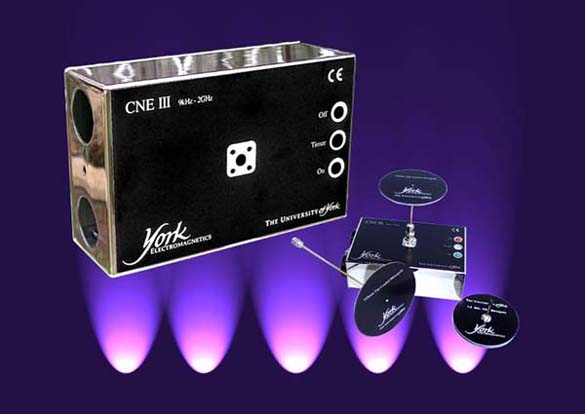![]()
Perancea Design Capabilities Prove Sound For Noise Emitter Repackaging

When the University of York needed the skills of designing for manufacture and EMC, it turned to Perancea to redesign the housing for its Comparison Noise Emitter reference source. Destined for life in the EMC sector, it was crucial that the housing looked and played the part!
Despite adequate packaging in a standard die-cast box, the York Electronics Centre product lacked aesthetics comparable to its technical capabilities and price. The York Electronics Centre at the University of York's Department of Electronics, needed to commercialise and improve the appearance of what was already an internationally accepted reference source to make it even more appealing to even more potential customers.
Perancea's task, given the parameters of maintaining similar manufacturing costs, was simply to upgrade the noise emitter's appearance. That also included maintaining or even improving the existing screening properties of the housing. The redesigned housing had to be a single source solution, complete with graphics, customisation for through wall mounted components and internal mountings for easy assembly.
Notably, the York Electronics Centre had reservations that the specifications required could be achieved whilst still keeping pricing competitive in low volume production quantities of 20/30 units per annum. On that score, Perancea was a force to be reckoned with!
From a design and manufacturing perspective, Perancea went for the simple and direct sheet metal construction approach to the housing. In its developed stage, all holes were punched and corners were notched in the 18swg mild steel sheet, using one of the company's Nisshinbo CNC punching presses. The punched holes included two at 34mm diameter complete with keyway orientation slots on one end of the housing. Maintaining accuracy was extremely important throughout, for example, for hole alignment after bending, at final assembly and for fitting the internal electronics equipment as well as the lid.
Studs and threaded inserts were staked and welded in, together with a spot welded shielding can sub-assembly complete with its own lid. The shielding can and lid were also sheet metal fabricated by Perancea. The 'sub-assembled' sheets were then folded on a CNC Promecan brake press.
Finally, the butt jointed corners of the box were welded and dressed and the final enclosure was then nickel plated, polished and reverse screen printed. Complete with nickel plated and polished lid, which was designed as the base of the housing, the assembly measured up at 187x119x61mm.
Compared to a die-casting and its necessary post machining, the new design easily met the improved criteria. The previous design - an unpainted economy die-casting - had a black, self-adhesive vinyl label stuck on its top and required the internal shielding can, which also used to be a die-casting to be sourced and then machined and fettled separately before assembly.
Perancea's sheet metal fabricated solution, based on lower cost materials, enabled single sourcing of the complete housing and internal shielding can sub-assembly, whilst also providing greater EMC screening attributes and a very aesthetic, chrome-like appearance.
Bernard Hancock, the York Electronics Centre's Chief Electronics Technician pointed out that the revised casing not only has marked, repeatable fabrication performance but also is immensely cheaper to manufacture. "Because we previously had to machine two die-castings, manufacturing costs have dramatically reduced," he said. "And in assembly, with the new fabricated design, it is always possible to mount a circuit board flat in the base. But the real difference," he concluded, "is the improved look and appearance which is producing a very positive response from customers."
York EMC Services Ltd., a company spun out of the York Electronics Centre, now markets the Comparison Noise Emitter. In operation, the Comparison Noise Emitter is a high value research tool for the evaluation of screened room resonances. It has been used nationally and internationally including by UKAS. The unit provides a continuous broadband noise source with a usable output from 9kHz to 2GHZ and comes complete with three monopole antennas to provide a radiating field source.
Applications range from open area test sites to anechoic chambers, enabling the monitoring of criteria that would be missed by a comb generator. Compared to alternative impulsive noise sources, the York EMC emitter avoids overloads and the subsequent liability to damage of sensitive receiving equipment input circuits. The emitter can also be used for radiated and conductive measurement tests, providing a reference source for daily pre-test checking for accreditation services and authorities, as well as for long term monitoring and cable position investigation. The unit will also measure cable losses, characterise filter performance and provide vital data in the investigation of screened room behaviour.
The microprocessor
based design is battery powered to keep spurious emission to an absolute minimum,
enabling operation as a 'small' source and obviating the effects of cabling
that could modify the fields generated.